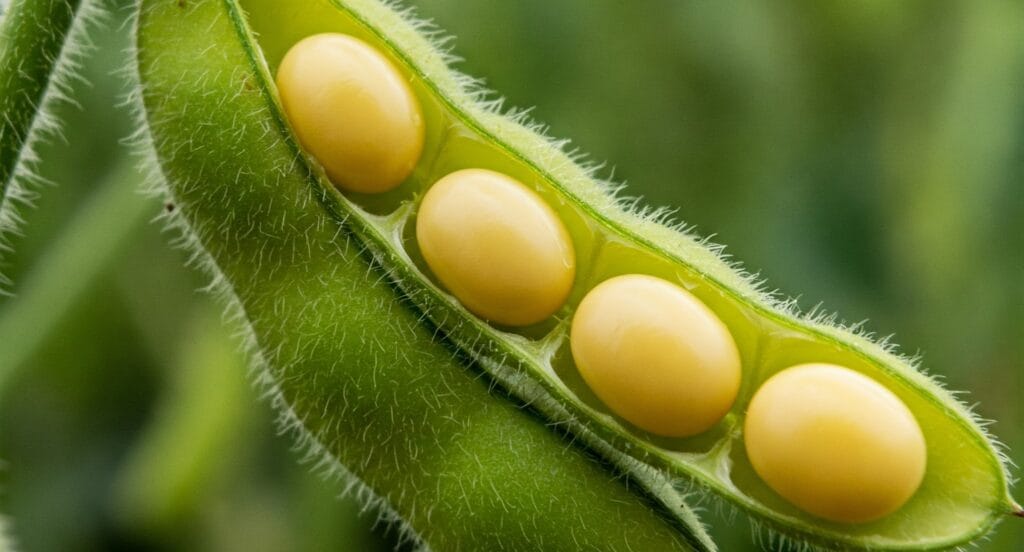Soybean (Glycine max)
Origin and History
- Origin: East Asia (mainly China).
- Domestication: Over 5000 years ago.
- Introduced to India: Early 20th century but became popular only after 1970s.
General Information
- Soybean is the major oilseed crop of the world.
- Accounts for 50% of total oilseed area and production globally.
- Provides approximately 60% of the world’s vegetable protein and 30% of the world’s vegetable oil.
- Known as the “Wonder crop” and “Meat for the poor”.
- It is the richest, cheapest, and easiest source of best quality proteins and fats.
Botanical Features
- Prophylls: Tiny paired simple leaves (< 1 mm) present at the base of each lateral branch.
- First nodules: Visible around 10 days after sowing.
- Photosynthesis Type: C3 plant (like maize).
- Root Nodulation: Effective for biological nitrogen fixation.
Area, Production, and Leading States in India (latest trends)
|
Aspect |
Details |
|
Area (India) |
~12 million hectares (as of 2023) |
|
Top Producing States |
Madhya Pradesh > Maharashtra > Rajasthan > Karnataka |
|
Leading Districts |
Indore, Ujjain, Nagpur belt |
|
Contribution |
India ranks 5th in the world after USA, Brazil, Argentina, and China. |
|
Major Export |
Soymeal for poultry and livestock feed |
Chemical Composition
|
Component |
Content (%) |
|
Oil Content |
20% |
|
Protein Content |
40% |
|
Linoleic Acid |
56–60% (unsaturated fat) |
|
Oleic Acid |
30–35% |
|
Linolenic Acid |
5–10% |
|
Saturated Fatty Acids |
12–14% (palmitic & stearic acids) |
- Amino Acids:
- High: Lysine (6.2%), Tryptophan (1.4%)
- Low: Methionine (1.2%), Cystine (0.8%)
- Vitamins: Good amount of Vitamin B complex.
Climatic Requirements
|
Factor |
Requirement |
|
Temperature |
20–30°C optimal |
|
Rainfall |
600–1000 mm (well-distributed) |
|
Photoperiod |
Short day plant (prefers 12–14 hrs darkness) |
|
Soil |
Well-drained loamy soils with pH 6.0–7.5 |
|
Sensitive to |
Waterlogging and salinity |
- Climatic requirement similar to maize.
Agronomy (Cultural Practices)
- Sowing Time:
- Kharif season: June–July
- Spring sowing (some areas): February–March
- Seed Rate: 75–80 kg/ha
- Spacing: 45–60 cm (row-to-row) × 5–10 cm (plant-to-plant)
- Depth of sowing: 3–5 cm
- Fertilizer Requirement (general recommendation):
- Nitrogen (N): 20–30 kg/ha
- Phosphorus (P₂O₅): 60–75 kg/ha
- Potash (K₂O): 30–40 kg/ha
- Inoculation: Seeds are often treated with Rhizobium japonicum for better nitrogen fixation.
- Irrigation:
- Critical stages: flowering and pod filling.
- Drought-sensitive at flowering stage.
Pests and Diseases
|
Problem |
Description/Control |
|
Soybean rust |
Fungus disease, controlled by fungicides like Mancozeb |
|
Stem fly |
Major insect, use of systemic insecticides |
|
Girdle beetle |
Stem and pod damage |
|
Root rot and stem rot |
Due to poor drainage, managed by crop rotation |
Weed Management
|
Herbicide |
Type |
Dose |
|
Nitrofen (TOK-25) |
Pre-emergence selective |
1.5–2.0 kg a.i./ha in 800–1000 L water |
|
Fluchloralin (Basalin) |
Pre-plant incorporation |
1.0 kg a.i./ha |
|
Metribuzin (Sencor) |
Pre-emergence |
1.0 kg a.i./ha |
- Effective against annual grasses and broadleaf weeds.
Oil Properties
- Iodine number: 140 (indicates degree of unsaturation; higher means more unsaturated).
- Comparison:
- Soybean Oil: 140
- Linseed Oil: 180
- Iodine Value Measurement: Done by Hanus Method.
❗ Special Notes
- Not used as Dal: Presence of lipoxidase enzyme causes off-flavour when split into dal.
- Antinutritional Factors: Trypsin inhibitors, hemagglutinins, oligosaccharides present.
Important MCQ Facts (Quick Recap)
- Botanical name: Glycine max
- Origin: East Asia
- Oil content: ~20%
- Protein content: ~40%
- First nodules appear: 10 days after sowing
- Linoleic acid content: 56–60%
- Pre-emergence herbicides: Nitrofen (TOK-25), Metribuzin (Sencor)
- Sowing depth: 3–5 cm
- Major pest: Stem fly
- Major disease: Soybean rust


